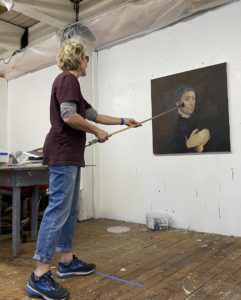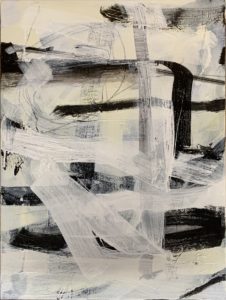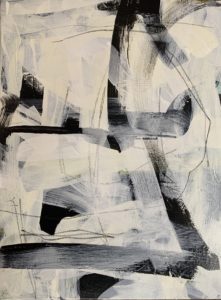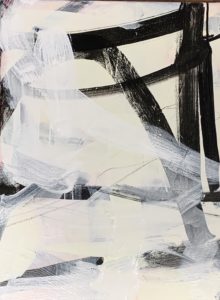Socially-Distanced Painting
By Kathryn Geismar | October 19, 2020
The social isolation during the past six months of the pandemic has changed the way we live and the way we think about in-person human interactions. I was curious to explore what would happen to my artwork if I imposed similar restrictions, i.e., standing at least six feet away from what I was making and trying to find a way to interact with whatever awkwardness and distance this would impose. My goal was not to make great art, but to have a visual recording of the kinds of distancing measures that now feel commonplace in our every day lives.
I created two different 6-foot long tools: one had a marker on one end and a grease pencil on the other; the second had a 12-millimeter (about .5 inches) brush on one end and a 1.5-inch brush on the other. I marked six feet from my wall with blue painter’s tape and decided I could stand further away but no closer than the six-foot mark. Because the brush “handles” were so long, I had to create my colors before painting (I usually mix them as I go) and put them on the floor on a palette that I could reach with my improvised tools.
I began by putting four 24×18 canvases up on the wall and trying to create marks. I started with the pencil and the pen, and found that my lines were much more tentative when made at such a distance, but once I began adding paint (just black and white for my first foray) I felt that the marks were surprisingly fresh and unplanned. I had very little control beyond choosing the direction and the duration of the mark, yet I enjoyed that the gestures that emerged were not the ones I had fully intended. (See larger images at the end of this post to view details.)
Since my non-abstract work is mostly portraiture, I decided to see how socially-distanced portrait painting might turn out. Before the pandemic, I had intended to use a book of Hans Memling portraits as inspiration for simplified face studies. Using a 30×30 canvas (I knew that I could not make small marks from such a distance) I randomly opened the book and began to work on a portrait of a praying monk. The background is dark and the flesh of the monk is all that is visible – it felt challenging but also simple in its composition.
I am still struggling with this piece. I move between feeling wedded to the Memling portrait on the one hand and wanting to let go of form and find color relationships and tonal relationships that might be laid down more simply and more successfully on the other. While I believe that all painting is abstract on some level, I am lured by the very restrictive palette and facial expression of the Memling portrait and I find myself struggling to let go of these details. From a distance, I have a desire to recognize the monk’s face and find it looking back at me from the wall. The struggle to accept the results of these interactions when so much is out of reach feels both difficult and somehow satisfying. Sometimes it is good to grapple formally in the studio with what is challenging outside of it.
Individual Canvases

Pandemic Painting single 1, acrylic, grease pencil, and marker on canvas, 24×18, 2020
Copyright © 2020 Kathryn Geismar
Kathryn Geismar is a psychologist and painter living and working in Somerville, Mass. Her work has been shown at the Danforth Museum, the Sloane Merrill Gallery, Galatea Fine Arts, the Bromfield Gallery, the St. Botolph Club, and the Cambridge and Concord art associations. She is a recent recipient of a Somerville Arts Council Fellowship grant which was derailed by the pandemic. She is represented by the Bromfield Gallery in SOWA, Boston.




